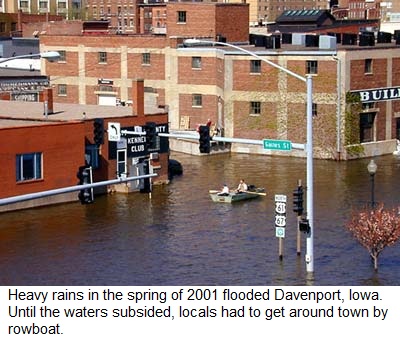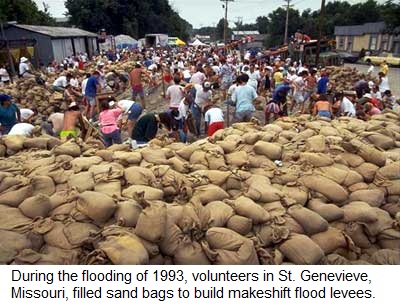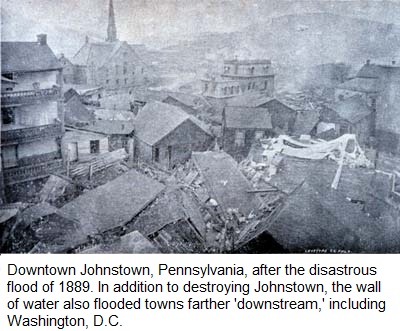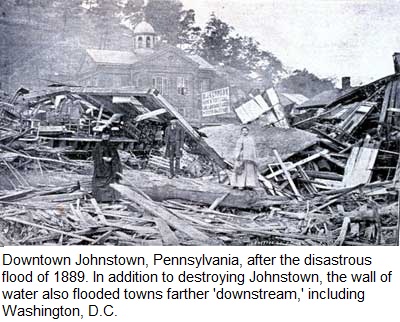|
|
|
|
 In
the last section, we saw that floods occur when an atypical volume of
water collects in an area. There are a number of ways this might happen,
and there are a wide range of events that occur when it does. In
the last section, we saw that floods occur when an atypical volume of
water collects in an area. There are a number of ways this might happen,
and there are a wide range of events that occur when it does.
The sort of flooding that most people are familiar with occurs when an
unusually large number of rainstorms hit an area in a fairly short
period of time. In this case, the rivers and streams that divert the
water to the ocean are simply overwhelmed. The varying temperatures of
different seasons leads to different weather patterns. In the winter,
for example, the air over the ocean might be warmer than the air over
the land, causing the wind flow to move from the land out to sea. But in
the summer, the air over the land heats up, becoming warmer than the air
over the ocean. This causes the wind current to reverse, so that more
water from the ocean is picked up and carried over land. This monsoon
wind system can cause a period of intense rain that is completely out of
step with the climate the rest of the year. In some areas, this flooding
may be exacerbated by excess water from melting snow.
 Perhaps
the best known example of seasonal flooding is the annual expansion of
the Nile River in Egypt. In Ancient Egypt, monsoon rains at the source
of the river would cause the waterway to extend out a good distance
during the summer. In this case, the flooding was not a disaster, but a
godsend. The expanding waters would leave fertile silt all along the
banks of the river, making the area ideal farming land once the river
had subsided again. This is one of the main factors that allowed
civilization to thrive in the Egyptian desert. These days, the river is
blocked off by a dam upstream, which collects the summer rain and doles
it out throughout the year. This has extended the planting season so
that Egyptian farms can grow crops year-round. Perhaps
the best known example of seasonal flooding is the annual expansion of
the Nile River in Egypt. In Ancient Egypt, monsoon rains at the source
of the river would cause the waterway to extend out a good distance
during the summer. In this case, the flooding was not a disaster, but a
godsend. The expanding waters would leave fertile silt all along the
banks of the river, making the area ideal farming land once the river
had subsided again. This is one of the main factors that allowed
civilization to thrive in the Egyptian desert. These days, the river is
blocked off by a dam upstream, which collects the summer rain and doles
it out throughout the year. This has extended the planting season so
that Egyptian farms can grow crops year-round.
Another common source of flooding is unusual tidal activity that extends
the reach of the ocean farther inland than normal. This might be caused
by particular wind patterns that push the ocean water in an unusual
direction. It can also be caused by tsunamis, large waves in the ocean
triggered by a shift in the Earth's crust.
 Floods
may also occur when a man-made dam breaks. We build dams to modify the
flow of rivers to suit our own purposes. Basically, the dam collects the
river water in a large reservoir so that we can decide when to increase
or decrease the river's flow, rather than letting nature decide.
Engineers build dams that will stand up to any amount of water that is
likely to accumulate. Occasionally, however, more water accumulates than
the engineers predicted, and the dam structure breaks under pressure.
When this happens, a massive amount of water is released all at once,
causing a violent "wall" of water to push across the land. In 1889, such
a flood occurred in Johnstown, Pennsylvania. The townspeople were warned
that the flood was coming, but many dismissed the alert as unfounded
panic. When the rushing wall of water did hit, more than 2,000 people
were killed in only a few minutes. Floods
may also occur when a man-made dam breaks. We build dams to modify the
flow of rivers to suit our own purposes. Basically, the dam collects the
river water in a large reservoir so that we can decide when to increase
or decrease the river's flow, rather than letting nature decide.
Engineers build dams that will stand up to any amount of water that is
likely to accumulate. Occasionally, however, more water accumulates than
the engineers predicted, and the dam structure breaks under pressure.
When this happens, a massive amount of water is released all at once,
causing a violent "wall" of water to push across the land. In 1889, such
a flood occurred in Johnstown, Pennsylvania. The townspeople were warned
that the flood was coming, but many dismissed the alert as unfounded
panic. When the rushing wall of water did hit, more than 2,000 people
were killed in only a few minutes.
 The
severity of a flood depends not only on the amount of water that
accumulates in a period of time, but also on the land's ability to deal
with this water. As we've seen, one element of this is the size of
rivers and streams in an area. But an equally important factor is the
land's absorbency. When it rains, soil acts as a sort of sponge. When
the land is saturated -- that is, has soaked up all the water it can --
any more water that accumulates must flow as runoff. The
severity of a flood depends not only on the amount of water that
accumulates in a period of time, but also on the land's ability to deal
with this water. As we've seen, one element of this is the size of
rivers and streams in an area. But an equally important factor is the
land's absorbency. When it rains, soil acts as a sort of sponge. When
the land is saturated -- that is, has soaked up all the water it can --
any more water that accumulates must flow as runoff.
Some materials become saturated much more quickly than others. To see
how this works, just take a bucket of water outside and try wetting
various surfaces. Soil in the middle of the forest is an excellent
sponge. You could dump several buckets of water on it and it would soak
the water right up. Rock is not so absorbent -- it doesn't seem to soak
up any water at all. Hard clay falls somewhere in between. Generally,
soil that has been tilled for crops is less absorbent than uncultivated
land, so farm areas may be more likely to experience flooding than
natural areas.
One of the least absorbent surfaces around is concrete. In the next
section, we'll see how concrete, asphalt and other human construction
can affect flooding.

Source: http://science.howstuffworks.com |
|


 In
the last section, we saw that floods occur when an atypical volume of
water collects in an area. There are a number of ways this might happen,
and there are a wide range of events that occur when it does.
In
the last section, we saw that floods occur when an atypical volume of
water collects in an area. There are a number of ways this might happen,
and there are a wide range of events that occur when it does. Perhaps
the best known example of seasonal flooding is the annual expansion of
the Nile River in Egypt. In Ancient Egypt, monsoon rains at the source
of the river would cause the waterway to extend out a good distance
during the summer. In this case, the flooding was not a disaster, but a
godsend. The expanding waters would leave fertile silt all along the
banks of the river, making the area ideal farming land once the river
had subsided again. This is one of the main factors that allowed
civilization to thrive in the Egyptian desert. These days, the river is
blocked off by a dam upstream, which collects the summer rain and doles
it out throughout the year. This has extended the planting season so
that Egyptian farms can grow crops year-round.
Perhaps
the best known example of seasonal flooding is the annual expansion of
the Nile River in Egypt. In Ancient Egypt, monsoon rains at the source
of the river would cause the waterway to extend out a good distance
during the summer. In this case, the flooding was not a disaster, but a
godsend. The expanding waters would leave fertile silt all along the
banks of the river, making the area ideal farming land once the river
had subsided again. This is one of the main factors that allowed
civilization to thrive in the Egyptian desert. These days, the river is
blocked off by a dam upstream, which collects the summer rain and doles
it out throughout the year. This has extended the planting season so
that Egyptian farms can grow crops year-round. Floods
may also occur when a man-made dam breaks. We build dams to modify the
flow of rivers to suit our own purposes. Basically, the dam collects the
river water in a large reservoir so that we can decide when to increase
or decrease the river's flow, rather than letting nature decide.
Engineers build dams that will stand up to any amount of water that is
likely to accumulate. Occasionally, however, more water accumulates than
the engineers predicted, and the dam structure breaks under pressure.
When this happens, a massive amount of water is released all at once,
causing a violent "wall" of water to push across the land. In 1889, such
a flood occurred in Johnstown, Pennsylvania. The townspeople were warned
that the flood was coming, but many dismissed the alert as unfounded
panic. When the rushing wall of water did hit, more than 2,000 people
were killed in only a few minutes.
Floods
may also occur when a man-made dam breaks. We build dams to modify the
flow of rivers to suit our own purposes. Basically, the dam collects the
river water in a large reservoir so that we can decide when to increase
or decrease the river's flow, rather than letting nature decide.
Engineers build dams that will stand up to any amount of water that is
likely to accumulate. Occasionally, however, more water accumulates than
the engineers predicted, and the dam structure breaks under pressure.
When this happens, a massive amount of water is released all at once,
causing a violent "wall" of water to push across the land. In 1889, such
a flood occurred in Johnstown, Pennsylvania. The townspeople were warned
that the flood was coming, but many dismissed the alert as unfounded
panic. When the rushing wall of water did hit, more than 2,000 people
were killed in only a few minutes. The
severity of a flood depends not only on the amount of water that
accumulates in a period of time, but also on the land's ability to deal
with this water. As we've seen, one element of this is the size of
rivers and streams in an area. But an equally important factor is the
land's absorbency. When it rains, soil acts as a sort of sponge. When
the land is saturated -- that is, has soaked up all the water it can --
any more water that accumulates must flow as runoff.
The
severity of a flood depends not only on the amount of water that
accumulates in a period of time, but also on the land's ability to deal
with this water. As we've seen, one element of this is the size of
rivers and streams in an area. But an equally important factor is the
land's absorbency. When it rains, soil acts as a sort of sponge. When
the land is saturated -- that is, has soaked up all the water it can --
any more water that accumulates must flow as runoff.